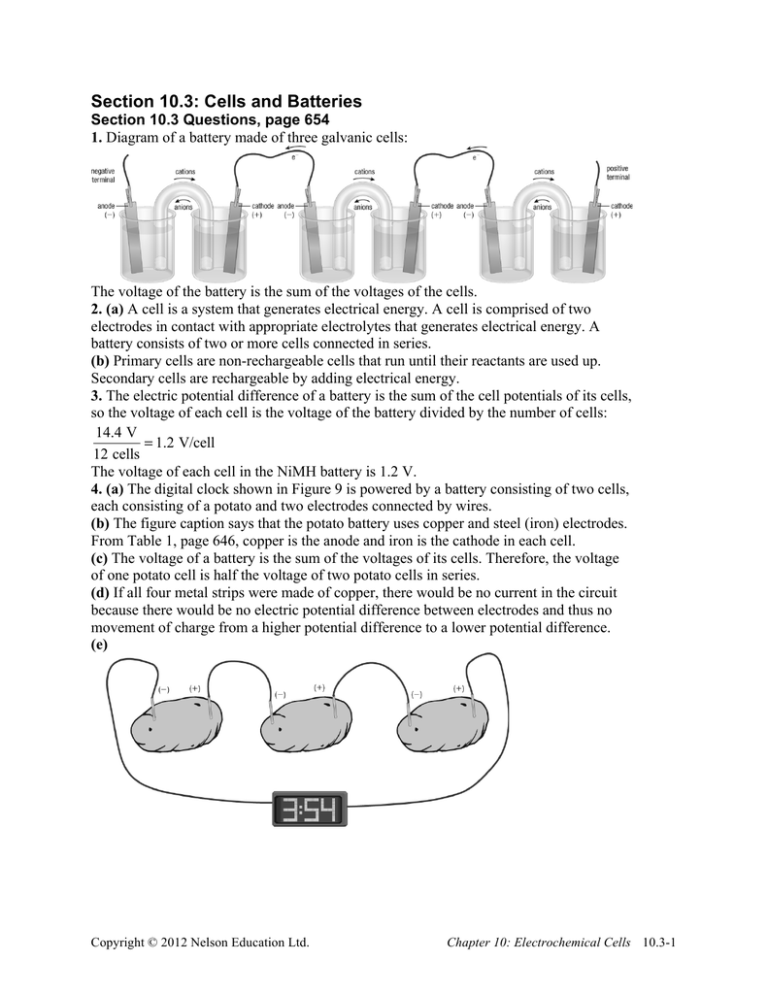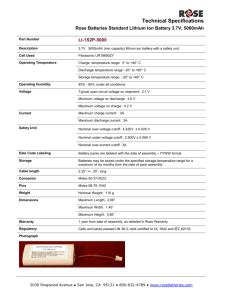Cells and Batteries: Galvanic Cells, Batteries, and Electrochemistry
advertisement

Section 10.3: Cells and Batteries Section 10.3 Questions, page 654 1. Diagram of a battery made of three galvanic cells: The voltage of the battery is the sum of the voltages of the cells. 2. (a) A cell is a system that generates electrical energy. A cell is comprised of two electrodes in contact with appropriate electrolytes that generates electrical energy. A battery consists of two or more cells connected in series. (b) Primary cells are non-rechargeable cells that run until their reactants are used up. Secondary cells are rechargeable by adding electrical energy. 3. The electric potential difference of a battery is the sum of the cell potentials of its cells, so the voltage of each cell is the voltage of the battery divided by the number of cells: 14.4 V = 1.2 V/cell 12 cells The voltage of each cell in the NiMH battery is 1.2 V. 4. (a) The digital clock shown in Figure 9 is powered by a battery consisting of two cells, each consisting of a potato and two electrodes connected by wires. (b) The figure caption says that the potato battery uses copper and steel (iron) electrodes. From Table 1, page 646, copper is the anode and iron is the cathode in each cell. (c) The voltage of a battery is the sum of the voltages of its cells. Therefore, the voltage of one potato cell is half the voltage of two potato cells in series. (d) If all four metal strips were made of copper, there would be no current in the circuit because there would be no electric potential difference between electrodes and thus no movement of charge from a higher potential difference to a lower potential difference. (e) Copyright © 2012 Nelson Education Ltd. Chapter 10: Electrochemical Cells 10.3-1 5. (a) The function of the separator in an alkaline dry cell and lithium-ion cell is to prevent the chemicals in the half-cells from coming into direct contact. (b) The separator must be porous to allow ions to flow from one half-cell to the other, acting like a salt bridge. 6. The fact that some of the lead(II) sulfate that is produced in the cathode reaction in a lead storage battery falls off the surface of the electrode to the bottom of the battery limits the life of the battery because the reactants—lead and sulfuric acid—are being used up. 7. (a) Secondary cells are appropriate for personal electronic equipment because they can be recharged, thus saving money that would otherwise be spent on replacement primary cells. If primary cells were used for all personal electronic equipment, more primary cells would end up in the garbage, contributing to more waste. (b) The ideal battery for a camera should be long-lasting so that many photos can be taken before the battery needs to be recharged. 8. (a) An aqueous solvent cannot be used in a lithium-ion cell because lithium is one of the strongest reducing agents and is thus very reactive. Because lithium is an alkali metal, it reacts vigorously with water. (b) The potential for the lithium-ion cell is greater than the potential for a cell constructed using any other reducing agent because, as the strongest reducing agent, lithium has the greatest potential difference with respect to an oxidizing agent than any other reducing agent. 9. Answers may vary. Sample answer: The fact that much of the world’s lithium supply comes from Chile might affect the widespread use of lithium-ion batteries to supply energy for electric cars because the world’s supply of lithium is concentrated in one country. If the lithium supply in Chile runs out, developers will need to find another source of lithium or an alternative to lithium to power the various devices for which lithium is currently needed. 10. Answers may vary. Sample answer: Even though car manufacturers have begun developing cars powered by hydrogen fuel cells, some, such as Ford, have stopped work on hydrogen cars to focus on electric cars. Others, such as GM, have reduced their research and development programs on hydrogen cars because building these vehicles is very expensive. 11. Answers may vary. Sample answer: Types of ground-based transportation that are currently powered by hydrogen fuel cells include motorcycles, buses, trains, PHB bicycles, cargo bikes, golf carts, and wheelchairs. Hydrogen gas for fuel cells can be obtained from methane on a large scale by reacting methane with steam at high temperature. To obtain hydrogen gas on a smaller scale to supply fuel cells, diesel fuel is being considered. Copyright © 2012 Nelson Education Ltd. Chapter 10: Electrochemical Cells 10.3-2




